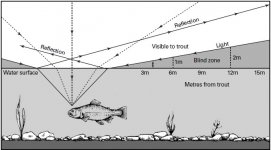T
tomitrout
Active member
- Joined
- Jun 9, 2010
- Messages
- 1,539
uhmm, no, sorry pcray, I am talking about spooking fish....false casts over risers from downstream will spook fish, lining a fish from downstream will spook a fish. Change up the presentation, and you just might spook less fish.
At the footbridge on the upper Letort for example, there's often a trout holding in a feeding position near the piling on the 81 side. Lot's of folks, joggers, dog walkers, etc use the path and that fish will spook easily when approached from the 81 side of the bridge...but approach him from the quarry side and you can usually sneak a few casts before he's onto you. They're also in tune to your footsteps there, I can often slowly pedal my bike right onto the bridge, rest against the railing and gaze down on him as he feeds, but as soon as you step on the bridge...gone.
The fish in these high pressure areas become accustomed to people entering the water at existing access points, they hear or feel your footsteps and bolt from the lie that's near that access. Change up your approach and sneak up to them from a different angle than they expect and you'll have a better chance of not spooking them...
At the footbridge on the upper Letort for example, there's often a trout holding in a feeding position near the piling on the 81 side. Lot's of folks, joggers, dog walkers, etc use the path and that fish will spook easily when approached from the 81 side of the bridge...but approach him from the quarry side and you can usually sneak a few casts before he's onto you. They're also in tune to your footsteps there, I can often slowly pedal my bike right onto the bridge, rest against the railing and gaze down on him as he feeds, but as soon as you step on the bridge...gone.
The fish in these high pressure areas become accustomed to people entering the water at existing access points, they hear or feel your footsteps and bolt from the lie that's near that access. Change up your approach and sneak up to them from a different angle than they expect and you'll have a better chance of not spooking them...





